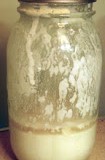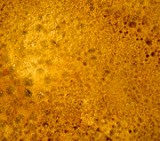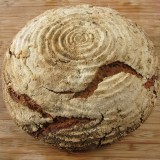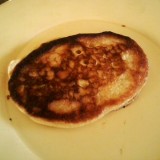
One the many searches that leads folks to this cranky web site is the topic of the Ethiopian sponge bread known as injera. We think we know what’s going on. People go out to dinner at an Ethiopian restaurant and come home wondering how to make the bread, leading to a fruitless search of the internets for a recipe and our old post about one of the ingredients, teff flour.
 The recipe we used comes from the excellent book Wild Fermentation by Sandor Ellix Katz. This is a life changing recipe book that every urban homesteader should own–so go out and buy a copy!
The recipe we used comes from the excellent book Wild Fermentation by Sandor Ellix Katz. This is a life changing recipe book that every urban homesteader should own–so go out and buy a copy!
So here’s how we made injera based on Katz’s recipe:
Ingredients
2 cups sourdough starter (check out our post on an easy way to keep and maintain a sourdough starter)
5 cups lukewarm water
2 cups whole-wheat flour
2 cups teff flour (an Ethiopian grain available from Bob’s Red Mill at Whole Foods)
1 teaspoon salt
1 teaspoon baking soda or baking powder (optional)
Vegetable oil
1. Mix the sourdough starter, flours and water. The result should resemble a pancake batter.
2. Ferment in a warm place for 24 hours.
3. Just before you cook add the salt.
4. Katz gives several options with the baking powder/soda. He says that if you like the sour flavor and don’t mind a less bubbly bread skip the baking soda. We like sour, but we thought the final result was too sour so we added the baking soda. Katz says that using baking powder will provide leavening but leave the dough sour. Again, we recommend adding some baking soda.
5. Stir well and let sit for a few minutes after adding baking soda or powder.
6. Heat up a pan and and lightly coat it with oil.
7. Spread the batter thinly in the pan and cook on one side only. Cover the pan and cook the injera over medium heat.
Injera works as both bread and utensil and the batch we made tasted better than what we’ve been served in restaurants.





I like your injera dish. Looks yummy.
Thank you for your detailed starter recipes.
From my experience of baking injera, the baking soda/powder, self-rising flour or commercial yeast alters the real taste & texture of teff injera. I say, the restaurants here in the US have the look alike of the injera, but far from the real taste & texture of injera. Sorry but the truth. Just by using one of your starters you can bake good decent injera. No need to add the baking powder/soda.Trust me.
See, the reason injera is always sour dough back home is, that it will take some of the bite out of that spicy rather hot stew (doro-wote- spicy, hot chicken & hard boiled egg stew ).
I remember, once I invited a friend of mine (American of course) for lunch. Served this real doro-wote hot, I mean this was the real deal, real hot. Only I forgot to warn him. I remember his face turned pink & his eyes red, bulged out. O my God, what was I thinking? Well my first culture shock. That was some 27 years ago. Now I do not make doro wote that hot myself. I guess —when you live in Rome, —as the Romans,
This is an excellent recipe – the closest I’ve come to true injera at home, even though I didn’t have teff flour and used a white/wheat combo instead. I also used my own (Italian) sourdough culture. In other words, it’s a very forgiving recipe. I did, however, find that the breads bubbled best on high heat, giving them more of that real sponginess, than on medium. Thanks so much for the recipe.
How long do you cook after you cover it.